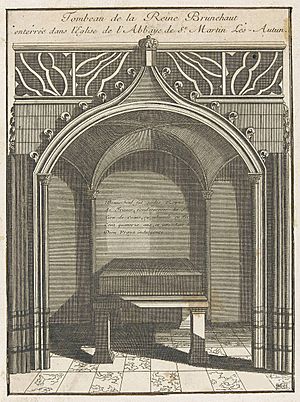Brunhilda of Austrasia facts for kids
Quick facts for kids Brunhilda |
|
|---|---|
| Queen of Austrasia | |
| Born | c. 543 Toledo |
| Died | 613 (aged 69–70) |
| Spouse |
|
| Issue |
|
| Father | Athanagild |
| Mother | Goiswintha |
Brunhilda (born around 543, died 613) was a powerful queen. She was married to Sigebert I of Austrasia, a king of the Franks. She also ruled as a regent for her son, grandsons, and great-grandson.
Her long life was full of important events. She led the eastern Frankish kingdoms of Austrasia and Burgundy. She was regent for her son Childebert II from 575 to 583. Later, she ruled for her grandsons Theudebert II and Theuderic II from 595 to 599. Finally, she was regent for her great-grandson Sigebert II in 613. During these times, there was often tension between the royal family and powerful nobles.
Brunhilda was a very strong and effective leader. But her forceful personality sometimes caused problems. She had conflicts with nobles, the church, and other royal family members. She had a very bitter rivalry with Fredegund. Fredegund was the wife of King Chilperic I of Neustria. Fredegund had murdered Brunhilda's sister, Queen Galswintha. This feud lasted until Fredegund's death in 597. Fredegund also arranged for Brunhilda's husband to be killed. Brunhilda was even put in prison for a while. Fredegund's son, Chlothar II, continued the fight. In 613, he defeated Brunhilda in battle and had her executed.
Contents
Brunhilda's Early Life and First Marriage
Brunhilda was likely born around 543. Her birthplace was Toledo, the capital of the Visigothic kingdom. She was the younger daughter of King Athanagild and Queen Goiswintha. Her father became king when she was only eleven years old. She received her education in Toledo.
In 567, Brunhilda married King Sigebert I of Austrasia. He was a grandson of Clovis I, a famous Frankish king. Sigebert sent many gifts to Toledo to arrange the marriage. Brunhilda then joined him in Metz. When they married, she changed her religion to Catholicism.
Sigebert's father, Chlothar I, had united the Frankish kingdoms. But after he died, Sigebert and his three brothers divided them again. A historian named Gregory of Tours said Sigebert's marriage was special. He chose a princess who was educated and had good morals. This was different from his brothers' choices.
Sigebert's brother, Chilperic I, then married Brunhilda's sister, Galswintha. Gregory of Tours thought Chilperic did this because he was jealous of Sigebert. But Chilperic soon grew tired of Galswintha. He and his favorite mistress, Fredegund, planned to kill her. In 568, Galswintha was killed while she slept. Chilperic then married Fredegund.
Brunhilda hated Fredegund for her sister's death. This hatred was returned just as strongly. The two queens convinced their husbands to go to war. Sigebert asked their older brother, Guntram of Burgundy, to help settle the fight. Guntram decided that the cities Galswintha brought to her marriage should go to Brunhilda. But Chilperic did not give up the cities easily. Brunhilda never forgot her sister's murder.
Between 567 and 570, Brunhilda and Sigebert had three children. Their names were Ingund, Chlodosind, and Childebert.
Chilperic broke the peace by attacking Sigebert's lands. Sigebert defeated Chilperic, who then ran away. The people of Paris cheered Sigebert when he arrived with Brunhilda and their children. A bishop named Germain asked Brunhilda to convince her husband to make peace. But Sigebert continued to fight Chilperic. Fredegund then hired two killers. They murdered Sigebert with poisoned daggers. Brunhilda was captured and put in prison in Rouen.
Brunhilda's Second Marriage and First Regency
Merovech, Chilperic's son from his first wife, visited Rouen. While there, he decided to marry Brunhilda. He hoped this would help him become king. But his stepmother, Fredegund, wanted only her own sons to be kings. Merovech and Brunhilda were married by a bishop. However, this marriage was against church rules because Brunhilda was Merovech's aunt.
Chilperic soon surrounded them in a church. He eventually made peace but took Merovech away. Chilperic tried to force Merovech to become a priest. Merovech escaped and later asked his servant to kill him.
Brunhilda then tried to rule Austrasia for her young son Childebert II. But the nobles strongly opposed her. She had to go to Guntram's court for a short time. Eventually, she succeeded in becoming regent. She was not a fighter but a skilled administrator. She fixed old Roman roads and built many churches and monasteries. She also built fortresses and improved royal finances. She made the royal army stronger. However, she angered the nobles by making royal authority stronger. To gain more power, she convinced Guntram to adopt Childebert as his son and heir. This happened in 577. In 579, she arranged for her daughter Ingund to marry a Visigothic prince. This created an alliance with her home country. But Ingund and her husband died in conflicts in Spain.
Brunhilda ruled Austrasia until Childebert became an adult in 583. He was thirteen, the traditional age for a Merovingian king to rule.
Conflicts and Later Regencies
The conflict with Fredegund started again when Chilperic died. Fredegund was now ruling Neustria. Brunhilda also had to deal with enemies among her own nobles.
Many dukes did not like Brunhilda's influence over her son Childebert. Some of them plotted to kill Childebert. But their plan was discovered. Guntram asked Childebert, Brunhilda, and Childebert's two sons to stay at his court for safety. In 587, Guntram, Childebert, and Brunhilda made an agreement. This agreement secured the kingdom of Burgundy for Childebert. It also created a lasting alliance between Austrasia and Burgundy.
In 592, Guntram died. Childebert became king of Burgundy as planned. He immediately went to war with Clotaire II of Neustria, Fredegund's son. In 593, Brunhilda's troops were defeated in battle. Childebert died in 596 when he was twenty-six.
After Childebert's death, Brunhilda tried to rule Austrasia and Burgundy for her grandsons. These were Theudebert II (king of Austrasia) and Theuderic II (king of Burgundy). Fredegund died in 597, ending their direct conflict. But the fight between their families continued.
In 599, Brunhilda's older grandson, Theudebert, sent her away. A peasant found her wandering and took her to Theuderic. Theuderic welcomed her and listened to her advice. She wanted revenge against Theudebert. Soon, the two brothers were at war.
During these later years, Brunhilda became very ruthless. A bishop named Desiderius of Vienne openly criticized her. In 612, he preached a sermon about purity in front of her and Theuderic. Brunhilda was so angry that she hired killers to murder the bishop.
Theuderic II's son, Sigebert II, became king after his father. Sigebert was still a child. The mayor of the palace, Warnachar, feared Brunhilda's influence. He brought Sigebert before an assembly of nobles. They declared Sigebert king of both kingdoms. But Brunhilda still had influence over him. So, for the last time, in her seventies, she was regent for her great-grandson.
However, Warnachar and other powerful nobles turned against Brunhilda. They joined with Clotaire II, Brunhilda's old enemy. They promised not to defend Brunhilda. Brunhilda and Sigebert met Clotaire's army. But the dukes betrayed her. She and the young king had to flee. They tried to get help from German tribes. But Clotaire's men caught them. The young king and his brother were killed. This ended the long and bloody feud. Clotaire reunited the Frankish kingdoms.
Clotaire then accused Brunhilda of causing the deaths of many kings and important people. Legend says she was dragged by a wild horse down a Roman road.
Brunhilda and the Church
Brunhilda was raised as an Arian Christian. But when she married Sigebert, she became a Catholic. She generally supported the church. She respected Pope Gregory the Great. He wrote positive letters to her. In 597, he wrote to her about stopping pagan practices. Gregory of Tours was another important church leader she favored. He was a trusted advisor to her and her son. Brunhilda also took a strong interest in churches and monasteries.
Brunhilda was buried in the Abbey of St. Martin at Autun. She founded this abbey in 602. The abbey and her tomb were destroyed in 1793. However, two parts of her tomb cover are now in a museum in Autun.
Brunhilda ordered the building of several churches. She also founded the Abbey of St. Vincent in Laon in 580. She is also believed to have built the castle of Bruniquel. She also had a Roman road resurfaced.
Brunhilda in Stories
Many experts believe Brunhilda inspired characters in the Nibelungenlied. This is a famous old German poem. She is seen as an inspiration for both Brunhild and Kriemhild. These are two rival characters in the poem. Kriemhild married Siegfried, who is similar to Sigebert, Brunhilda's husband. Many characters and events in the Nibelungenlied are similar to those from Brunhilda's time.
See also
- Barberini ivory
- In Spanish: Brunegilda para niños



